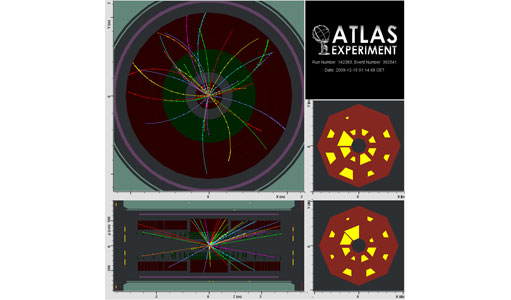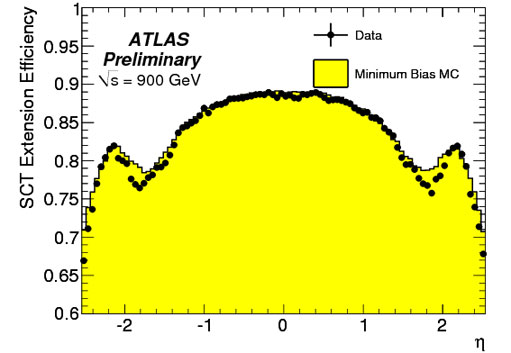
ATLAS e-News
23 February 2011
Minimum Bias, the first paper of ATLAS using LHC data
29 March 2010

A high multiplicity event selected with the Minimum Bias Trigger Scintillators.
When bunches of protons collide in the LHC the most likely resulting interaction produces low transverse momentum particles. The physics of these interactions is not completely described by perturbative Quantum Chromodynamics (QCD) without the addition of phenomenological models. These phenomenological models need to be tuned to data and therefore rely on experimental inputs.
Charged particle distributions from pp and ppbar interactions have previously been measured by several other collaborations at CERN and Fermilab. These measurements have typically been made using a double-arm scintillator trigger, and then further corrected using phenomenological models to obtain non-single-diffractive (NSD) measurements. Due to these model dependent corrections and the differences in measurement definitions used, previous measurements can be difficult to understand. The ATLAS analysis used a different approach, selecting events with a single-arm scintillator trigger and requiring one or more charged particles within the acceptance of the inner detector tracker volume. These requirements together with the high efficiency of the minimum bias trigger scintillators (MBTS), and their overlap with the tracker volume, were central to this model independent measurement.
The initial group of ATLAS physicists studying inclusive charge-particle spectra increased rapidly in size shortly before the 2009 LHC run period started. The team benefited from the support of analysis reviewers, physics conveners and top-level management. There was a close interaction with the inner detector community, which was vital to establish a good understanding of the tracking detector in a short time period. Immediately after the first data had been taken, activity reached fever pitch and was sustained through weekends (including a meeting that lasted until 11:30 pm on a Saturday night) and the Christmas break until the analysis was completed.
An important component of the analysis was to understand the track-reconstruction efficiency and its associated uncertainties. Ideally the efficiency should be measured directly from the data. However finding an appropriate reference can be challenging. Fortunately, it became clear almost immediately that the simulation in the inner detector described the data to an excellent level. Therefore the efficiency was taken from the simulation and systematic uncertainties were assessed to account for observed differences between data and simulation.

SCT extension efficiency as a function of pseudorapidity. The data are shown in black and are compared to the Geant4 simulation given in yellow.
The dominant uncertainty on the corrected charged-particle multiplicity spectra was determined to be caused by the difference between the simulated material and the amount of material within the inner detector. When charged particles traverse the inner detector volume they can undergo hadronic interactions with detector material. These interactions account for the majority of the track-reconstruction inefficiency. The real material content will soon be precisely determined using photon conversion events. However, so far not enough data has been recorded to measure the material with sufficient precision using this method. Therefore, alternative techniques were developed. One technique studied how often tracks reconstructed using information from the pixel detector extended into the SCT. This method is particularly sensitive to material located between the two silicon detectors, in the region in which many detector services are located. The second figure compares this efficiency between data and simulation, and shows excellent agreement in the barrel, but small discrepancies in the end caps. This was just one of many techniques which contributed to the assessment of the systematic uncertainty.
While the analysis continued un-abated it became clear that the paper had to be written in parallel. The efforts of the editorial board and the analysis reviewers were key to achieving this. In total 18 supporting internal documents were written by the analysis team to describe all aspects of the analysis. Three paper drafts were distributed to the collaboration and the paper benefited greatly from a large number of detailed comments. The success of this analysis and the paper in general was possible not only because of the dedicated efforts of all those directly involved, but also from the full support of the collaboration.
One of the final distributions from the paper is illustrated in the last figure. This is the distribution of charged particles as a function of pseudorapidity and clearly shows that the selected Monte Carlo models are 5-15% below the ATLAS 2009 data. These ATLAS data can already be used to improve phenomenological model tunes.
On the 16th of March, the paper entitled “Charged-particle multiplicities in pp interactions at √s = 900 GeV measured with the ATLAS detector at the LHC” was submitted to Physics Letters B.

The distribution of primary charged particles per unit pseudorapidity. The data points are black markers, with the systematic uncertainties are shown as green bands.

William BellUniversity of Geneva |

Heather GrayColumbia University
|